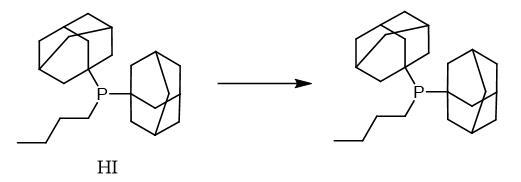|
| | Butyldi-1-adamantylphosphine Basic information | | Reaction |
| | Butyldi-1-adamantylphosphine Chemical Properties |
| Melting point | 100°C | | Boiling point | 449.6±12.0 °C(Predicted) | | storage temp. | Inert atmosphere,Room Temperature | | form | Powder | | color | white to yellow | | Sensitive | air sensitive | | BRN | 8726448 | | InChI | InChI=1S/C24H39P/c1-2-3-4-25(23-11-17-5-18(12-23)7-19(6-17)13-23)24-14-20-8-21(15-24)10-22(9-20)16-24/h17-22H,2-16H2,1H3 | | InChIKey | HTJWUNNIRKDDIV-UHFFFAOYSA-N | | SMILES | P(CCCC)(C12CC3CC(CC(C3)C1)C2)C12CC3CC(CC(C3)C1)C2 | | CAS DataBase Reference | 321921-71-5 |
| Safety Statements | 24/25 | | WGK Germany | 3 | | HS Code | 29310095 |
| | Butyldi-1-adamantylphosphine Usage And Synthesis |
| Reaction |
- Ligand for the Pd-catalyzed Suzuki coupling reaction.
- Ligand for the Pd-catalyzed formation of α-aryl ketones.
- Ligand for the Pd-catalyzed aminations
- Ligand for the Pd-catalyzed Heck reaction.
- Ligand used for arylation of benzoic acids.
- Ligand for the formylation of aryl bromides.
- Ni-catalyzed denitrogenative alkyne insertion reactions of triazoles.
- Ligand for palladium-catalyzed aminocarbonylation of aryl halides
- Palladium-catalyzed direct arylation of oxazole at C-5 with aryl bromides, chlorides, and triflates
- Palladium-catalyzed carbonylative sonogashira coupling of aryl bromides.


| | Physical properties | Butyldi-1-adamantylphosphine is a white to yellow solid with a melting
point of 100°C and an estimated boiling point of 449.6±12.0°C. Store at
room temperature, it is air sensitive. | | Uses | suzuki reaction | | Uses | CataCXium A is a catalyst. CataCXium A is an electron-rich phosphine ligand used for palladium catalyzed cross-coupling reactions like Heck and Suzuki coupling reactions. | | Uses | cataCXium A or di-adamantylalkylphosphine is a bulky and electron-rich phosphine ligand that is highly effective for palladium catalyzed cross-coupling reactions such as Heck and Suzuki coupling, Buchwald-Hartwig amination of aryl chlorides, and α-arylation reactions of ketones.
Other applications:
- palladium-catalyzed carbonylation of aryl and heteroaryl halides
- palladium-catalyzed synthesis of (hetero)aromatic nitriles
- palladium-catalyzed aminocarbonylation of aryl halides
| | General Description | Sold in collaboration with Solvias AG | | Synthesis | Phosphonium salt (2.2 mmol) was added to a cooled solution (- 78 ??C) of
Et3N
(4.44 g, 44 mmol) in di-n-butyl ether (20 mL). The reaction mixture was
stirred at -78 ??C for 5 h and then allowed to warm gradually to r.t.
The solvent was removed under vacuum and the residue was dissolved in
degassed EtOH (5 mL). After stirring for 15 min, the solid was filtered
off and dried to yield the desired phosphine, which can be further
purified by crystallization from EtOH. Butyldi-1-adamantylphosphine,
yield 90%.
31P NMR (C6D6)|?: 24.9. Mp 108-110??C. IR (KBr): 3425 (m, br),
2952 (s), 2847 (s), 2847 (s), 2675 (w), 1446 cm-1 (m). 1H NMR (250 MHz,
C6D6): |? = 0.96 (3 H, t, 3JH, H = 7.3 Hz, CH3), 1.35-2.03 (36 H, m,
adamantyl-30H, butyl-6H). 13C NMR (62 MHz, C6D6): |? = 41.3 (d, 2JC,P =
11.3 Hz, C-2), 37.4 (C-4), 36.1 (d, 1JC,P = 23.5 Hz, C-1), 33.9 (d,
1JC,P = 26.2 Hz, butyl-|á -CH2), 29.1 (d, 3JC,P = 7.6 Hz, C-3), 24.9 (d,
2JC,P = 13.1 Hz, butyl-|? -CH2), 17.1 (d, 3JC,P = 21.6 Hz, butyl-|? -CH2),
14.3 (butyl-CH3). MS (EI, 70 eV): m/z (%) = 358 (M+, 60), 135 (Ad+,
100). |
| | Butyldi-1-adamantylphosphine Preparation Products And Raw materials |
|





